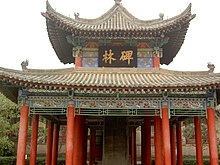FAIR and interactive data graphics from a scientific knowledge graph
Contents
| Stele Forest | |||||||||
|---|---|---|---|---|---|---|---|---|---|
 An entrance to the Stele Forest | |||||||||
| Chinese | 碑林 | ||||||||
| |||||||||

The Stele Forest or Beilin Museum is a museum for steles and stone sculptures in Beilin District in Xi'an, Northwest China. The museum, which is housed in a former Confucian Temple, has housed a growing collection of Steles since 1087. By 1944 it was the principal museum for Shaanxi province. Due to the large number of steles, it was officially renamed the Forest of Stone Steles in 1992. Altogether, there are 3,000 steles in the museum, which is divided into seven exhibitions halls that display works of Chinese calligraphy, painting and historical records.[1]
History
The Stele Forest began with the Kaicheng Shi Jing Steles (开成石经碑) and Shitai Xiao Jing Steles (石台孝经碑), two groups of steles both carved in the Tang dynasty and displayed in the temple to Confucius and the Imperial College in Chang'an, capital of the empire. In 904, a rebel army sacked Chang'an, and the steles were evacuated to the inner city. In 962, they were returned to the rebuilt temple. In the Song dynasty, a special hall with attached facilities was built to house and display the two stele groups. It was damaged in the 1556 Shaanxi earthquake during the Ming dynasty. In 1936, famous Chinese calligrapher Yu Youren donated his entire collection of more than three hundred rubbings from steles to the Xian Forest of Stele Museum.[2] It became a Major Historical and Cultural Site Protected at the National Level in 1961 and thus survived the Cultural Revolution.
Steles

It houses nearly 3,000 steles and it is the biggest collection of steles in China. Most of its exhibits are steles of the Tang dynasty. Ink rubbings of the steles are available for sale.
Among the unusual examples is an 18th-century stele depicting a Yangtze River flood control project. Another appears to be a bamboo forest, but on examination the leaves and branches form a poem.
The famous Xi'an Stele was moved to the Stele Forest in 1907, after the local authorities learned that the Danish adventurer Frits Holm was in town, trying to "obtain" the ancient monument and take it out of the country.[3]
- Cao Quan Stele (曹全碑, Han dynasty)
- Sima Fang Stele (司马芳碑, Jin dynasty)
- Kaicheng Shi Jing Stele (开成石经碑, Tang dynasty)
- Xi'an Stele (大秦景教流行中国碑, Tang dynasty)
Stone sculptures
- Four Steeds of Zhao Mausoleum (Tang dynasty)
The collections of the Beilin Museum are far more extensive than suggested by this inadequate thumbnail stub. To give but one example, artifacts produced by the ancient buddhasasansangha of part of China are well represented: Buddhist Sculpture from China: Selections from the Xi'an Beilin Museum Fifth through Ninth Centuries (China Institute Gallery, New York, 2007).
References
- ^ "Xi'an beilin Museum(西安碑林博物馆)". foreignercn.com. Retrieved 6 August 2014.
- ^ "The Modern Sage of Cursive Script: Yu Youren and his world of calligraphy". Archived from the original on 2011-09-02. Retrieved 2011-02-11.
- ^ Keevak, Michael (2008), The Story of a Stele: China's Nestorian Monument and Its Reception in the West, 1625-1916, pp. 117–121, ISBN 978-962-209-895-4
External links
![]() Media related to Stele Forest at Wikimedia Commons
Media related to Stele Forest at Wikimedia Commons
- (in Chinese) Xi'an Stele
- Xi'an Stele Forest Museum

















